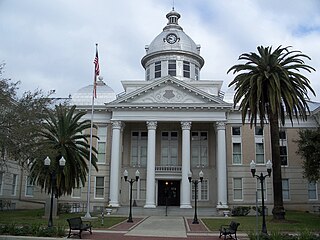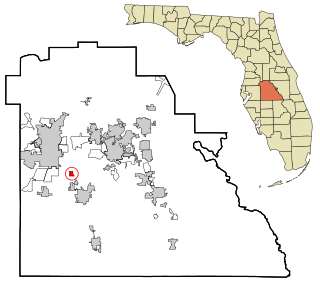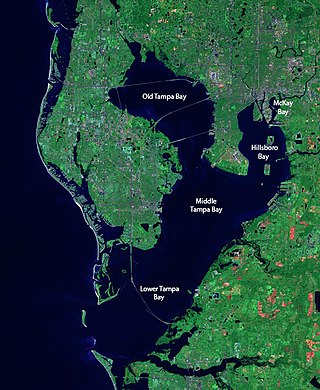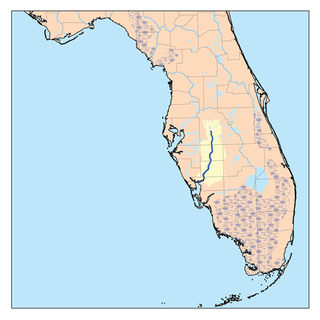
Polk County is located in the central portion of the U.S. state of Florida. The county population was 725,046, as of the 2020 census, and estimated to be 787,404, as of July 1, 2022. Its county seat is Bartow, and its largest city is Lakeland.

Blountstown is a city and the county seat of Calhoun County, Florida, United States.. As of the 2020 census, the city had a population of 2,266.

Punta Rassa is an unincorporated community and census-designated place (CDP) in Lee County, Florida, United States. The population was 1,620 at the 2020 census. It is part of the Cape Coral-Fort Myers, Florida Metropolitan Statistical Area.

Bartow is the county seat of Polk County, Florida, United States. Founded in 1851 as Fort Blount, the city was renamed in honor of Francis S. Bartow, the first brigade commander of the Confederate Army to die in combat during the American Civil War. According to the 2010 Census, the city had a population of 17,298 and an estimated population of 20,147 in 2019. It is part of the Lakeland−Winter Haven Metropolitan Statistical Area, which had an estimated population of 787,404, as of July 1, 2022. As of May 2023, the mayor of Bartow is Leo E. Longworth.

Eagle Lake is a city in Polk County, Florida, United States. The population was 3,174 as of 2021. It is part of the Lakeland–Winter Haven Metropolitan Statistical Area. Most of the town being centered around a subsection of U.S. Highway 17.

Highland City is a census-designated place (CDP) in Polk County, Florida, United States. The population was 2,051 at the 2000 census. It is part of the Lakeland–Winter Haven Metropolitan Statistical Area.

Lake Alfred is a city in Polk County, Florida, United States. The population was approximately 5,015 at the 2010 Census. It is part of the Lakeland–Winter Haven Metropolitan Statistical Area.

Lake Wales is a city in Polk County, Florida. The population was 14,225 at the 2010 census. As of 2019, the population estimated by the U.S. Census Bureau is 16,759. It is part of the Lakeland–Winter Haven Metropolitan Statistical Area. Lake Wales is located in central Florida, west of Lake Kissimmee and east of Tampa.

Lakeland is the most populous city in Polk County, Florida, United States, located along Interstate 4 east of Tampa. According to the 2020 U.S. Census Bureau release, the city had a population of 112,641. Lakeland is a principal city of the Lakeland–Winter Haven Metropolitan Statistical Area.

Winter Haven is a city in Polk County, Florida, United States. Neighboring Lakeland to its east, Winter Haven is located some fifty-one miles east of Tampa. The city's population was 49,219 at the 2020 census, making it the second most populated city in Polk County after Lakeland. It is a principal city of the Lakeland-Winter Haven, Florida Metropolitan Statistical Area which is part of the Tampa Bay metropolitan area.
The history of Florida can be traced to when the first Native Americans began to inhabit the peninsula as early as 14,000 years ago. They left behind artifacts and archeological evidence. Florida's written history begins with the arrival of Europeans; the Spanish explorer Juan Ponce de León in 1513 made the first textual records. The state received its name from that conquistador, who called the peninsula La Pascua Florida in recognition of the verdant landscape and because it was the Easter season, which the Spaniards called Pascua Florida.

Tampa Bay is a large natural harbor and shallow estuary connected to the Gulf of Mexico on the west-central coast of Florida, comprising Hillsborough Bay, McKay Bay, Old Tampa Bay, Middle Tampa Bay, and Lower Tampa Bay. The largest freshwater inflow into the bay is the Hillsborough River, which flows into Hillsborough Bay in downtown Tampa. Many other smaller rivers and streams also flow into Tampa Bay, resulting in a large watershed area.

Bartow Senior High School is the only high school in Bartow, Florida. It resulted from a merger of the whites-only Summerlin Institute and Union Academy, a school for African Americans, after desegregation.

Jacob Summerlin, aka the King of the Crackers and King of the Cracker Cow Hunters, was documented as the first child born in Florida after the land was ceded by Spain. This was again validated in about 2012-15 during Florida's 500-year celebration as Florida honored him as one of three people that were most influential in the past 500 years. Ponce de Leon was another of 3 honored.

The Peace River is a river in the southwestern part of the Florida peninsula, in the U.S.A. It originates at the juncture of Saddle Creek and Peace Creek northeast of Bartow in Polk County and flows south through Fort Meade Hardee County to Arcadia in DeSoto County and then southwest into the Charlotte Harbor estuary at Punta Gorda in Charlotte County. It is 106 miles (171 km) long and has a drainage basin of 1,367 square miles (3,540 km2). U.S. Highway 17 runs near and somewhat parallel to the river for much of its course. The river was called Rio de la Paz on 16th century Spanish charts. It appeared as Peas Creek or Pease Creek on later maps. The Creek Indians call it Talakchopcohatchee, River of Long Peas. Other cities along the Peace River include Fort Meade, Wauchula and Zolfo Springs.

The Withlacoochee River or Crooked River is a river in central Florida, in the United States. It originates in the Green Swamp, east of Polk City, flowing west, then north, then northwest and finally west again before emptying into the Gulf of Mexico near Yankeetown. The river is 141 miles (227 km) long and has a drainage basin of 1,170 square miles (3,000 km2). It is believed to have been named after the Withlacoochee River in the northern part of the state, near the border with Georgia.
The history of Fort Lauderdale, Florida began more than 4,000 years ago with the arrival of the first aboriginal natives, and later with the Tequesta Indians, who inhabited the area for more than a thousand years. Though control of the area changed among Spain, England, the United States, and the Confederate States of America, it remained largely undeveloped until the 20th century. The first settlement in the area was the site of a massacre at the beginning of the Second Seminole War, an event which precipitated the abandonment of the settlement and set back development in the area by over 50 years. The first United States stockade named Fort Lauderdale was built in 1838, and subsequently was a site of fighting during the Second Seminole War. The fort was abandoned in 1842, after the end of the war, and the area remained virtually unpopulated until the 1890s.
Homeland is an unincorporated community in Polk County, Florida, United States. It has a post office, a general store, and historical park. It is part of the Lakeland–Winter Haven Metropolitan Statistical Area.
Lake Hancock is north of Bartow, Florida in Polk County, Florida. It is ecologically important.
The Chain of Lakes is a famous series of lakes in Central Florida. There are two chains of lakes, the northern chain and the southern chain. The northern chain extends across three cities: Winter Haven, Lake Alfred, and Lake Hamilton. It has ten lakes, connected by a series of canals. The ten lakes on the northern chain are Lake Haines, Lake Rochelle, Lake Echo, Lake Conine, Lake Fannie, Lake Smart, Lake Henry, Lake Hamilton, Middle Lake Hamilton, and Little Lake Hamilton.

















